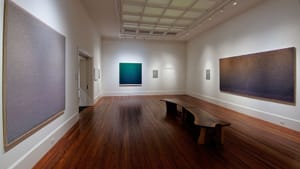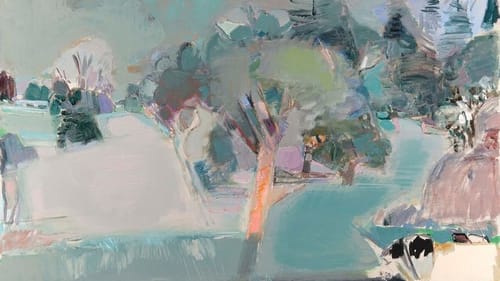Stay in the Loop
BSR publishes on a weekly schedule, with an email newsletter every Wednesday and Thursday morning. There’s no paywall, and subscribing is always free.
Painting with words
Woodmere Art Museum presents Hearing the Brush: The Painting and Poetry of Warren and Jane Rohrer

Warren and Jane Rohrer cultivate visions of nature in images and words. In Hearing the Brush, Woodmere Art Museum pairs Warren’s (1927-1995) paintings with Jane’s (b. 1928) poetry, inspiring reflection on the way a leaf falls, fields ready for planting, and the sting of fresh grief.
The Rohrers were raised in the Mennonite tradition, Jane Turner in Virginia’s Shenandoah Valley, and Warren in Lancaster County, Pennsylvania. Her compositions and his canvases are inspired by seasonal and rural rhythms, though these themes are more easily accessed in Jane’s plain-spoken lines than Warren’s abstract ones.
Nevertheless, Penn State art historian Christopher Reed sees rolling fields in Warren’s textured works: “There’s a kind of landscape reference. Often the little dots march uphill or downhill … There’s a kind of swelling, a kind of change that looks a little bit like the agricultural landscape.”
From a distance, Untitled (4) (1990-1994) appears pure white, but on approach, reveals modulated shades beneath the snowy surface, with bits of red peeking through. As with many of Warren's paintings, the surface undulates with what, in this instance, looks like wavy pairs of chromosomes. In Husk (1989), it’s little carets that might be hieroglyphics, treetops, or mountain peaks. Jane’s poem Fields in Snow refers to Warren’s use of enigmatic markings:
“Calligraphy, there on the contours of the
field, scribbling in stalks and stacks.”
A lifelong conversation
The Rohrers met at Eastern Mennonite College in Virginia, where Warren planned to enter the ministry, and Jane studied English. By the time they married in 1948, Warren had begun to pursue art.
Jane left school to support the couple. She would not begin writing until the 1970s, after their two sons were grown. Her first collection of poems would not be published until seven years after Warren’s death. Though her career was slow to emerge, Jane was influential in Warren’s work, naming paintings, organizing output, and serving as his sounding board. Sueyun Locks, director of Locks Gallery, says Warren’s career was a collaboration between the two: “Everything Warren was doing, he was talking to Jane.”
In 1961, the family moved to a farm in Christiana, Lancaster County, living there until the early 1980s, when they relocated to Philadelphia’s Mt. Airy neighborhood. By that time, Warren had been diagnosed with leukemia. (In Philadelphia, the Rohrers lived in the former home of artist Violet Oakley and her partner Edith Emerson. Emerson directed Woodmere Art Museum from the early 1940s to 1978.)

The Woodmere exhibition was organized in collaboration with Penn State’s 2021 Palmer Museum presentation Field Language: The Painting and Poetry of Warren and Jane Rohrer. This iteration pairs paintings and poems, enabling visitors to toggle between visual and verbal expressions. “We want … the poems to be able to open up the paintings and for the paintings likewise, to open up the poems,” said William R. Valerio, Woodmere director and CEO.
The combinations are a curatorial choice. Paired works were neither created in tandem nor during the same time period. The theme and mood of one does not necessarily complement those of its partner. Yet taken as a whole, the works on view represent two sides of a lifelong conversation. In the gallery, poems and paintings hang two to three feet apart, far enough for works to be considered on their own merits, close enough to imagine them as a tête-à-tête between artists.
Notes to an absent friend
According to Ann Hostetler, poet and Goshen College professor emerita, Jane is recognized as the first Mennonite poet to publish in the mainstream press. She became a contributor to American Poetry Review in the 1970s, long before her first collection, Life After Death (2002). A second collection, Acquiring Land: Late Poems, arrived in 2020. Hostetler recalled Jane saying once, half-seriously, that she hadn’t realized “one could pick up a pencil and write a poem until I was in my 40s.” The educator discussed the effect of Warren’s death on Jane's late-blooming career in a video produced for the Palmer exhibition: “Paradoxically, she only came into fullness of her own personal artistic achievement after the loss of that artistic communion.”
True enough, many of Jane’s poems obliquely refer to Warren’s absence. In Valentine she writes,
“Where you have gone, or go
I will send you a valentine of snow
in case you do not touch snow,
Now.”
In Swing, she muses,
“Will I arc on a velvet swing when I die
Will you be there when I go high
above my ancient tree to the sky”
Motion is a frequent element in her writing. In Place, Jane cruises the countryside, capturing what she sees:
“The words dappled with sunlight
floated across the open field
as I drove by.
You understand the dapples
did not float
or the sunlight
just the words
since by that time I had passed
and would never see
that green instant again.
Yet it is cut in permanence
and perfect
in my most real of archives
a small gallery
of moving forward
from another place
while I am here. “
The poem could caption Stream to Octorara, an uncharacteristically representational composition in which Warren suspends viewers over a brook carving through a grassy field. In the distance, a thirsty tree bends to the water, and a small yellow house pins the center of the canvas. The sky dominates in diluted blue and green, kissed with the apricot of sunset.
Fittingly, both artists’ work is described in terms of fields. Warren’s canvases have been said to represent the color field school of abstraction, and Jane composes in open field verse. How appropriate that their art is defined in elements that so shaped the artists themselves.
What, When, Where
Hearing the Brush: The Painting and Poetry of Warren and Jane Rohrer. Through July 10, 2022, at Woodmere Art Museum, 9201 Germantown Avenue, Philadelphia. (215) 247-0476 or woodmereartmuseum.org.
Consistent with CDC and City of Philadelphia guidelines, Woodmere does not require proof of vaccination or a negative Covid-19 test for admission. Mask-wearing is optional.
Accessibility
All Woodmere galleries are accessible, with the exception of the Dorothy del Bueno balcony. Accessible parking is available near the Widener Studio building, to the right of the museum, separate from the main parking area. Wheelchairs are available on request. For information and additional assistance, call (215) 247-0476 prior to visiting.
Sign up for our newsletter
All of the week's new articles, all in one place. Sign up for the free weekly BSR newsletters, and don't miss a conversation.
